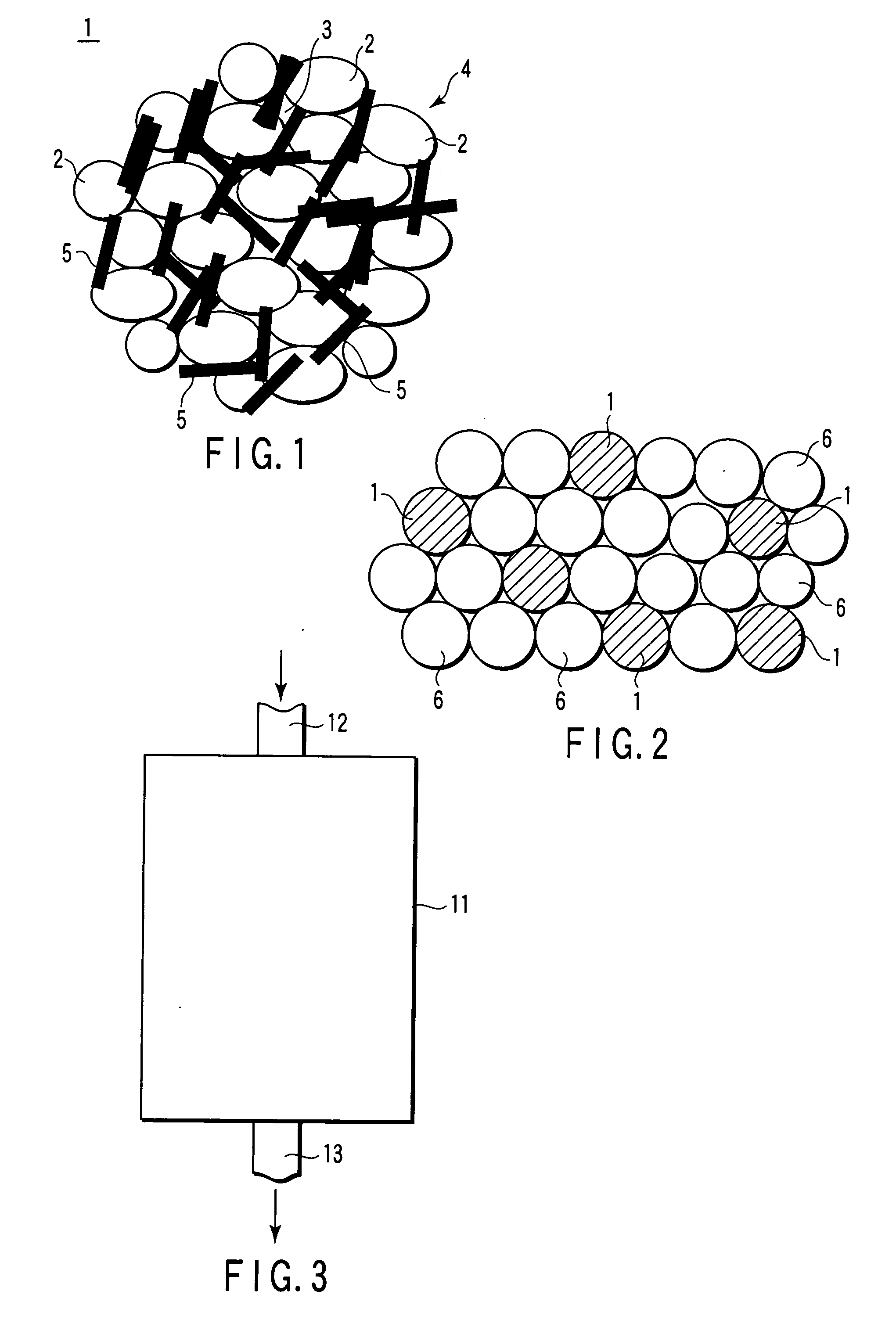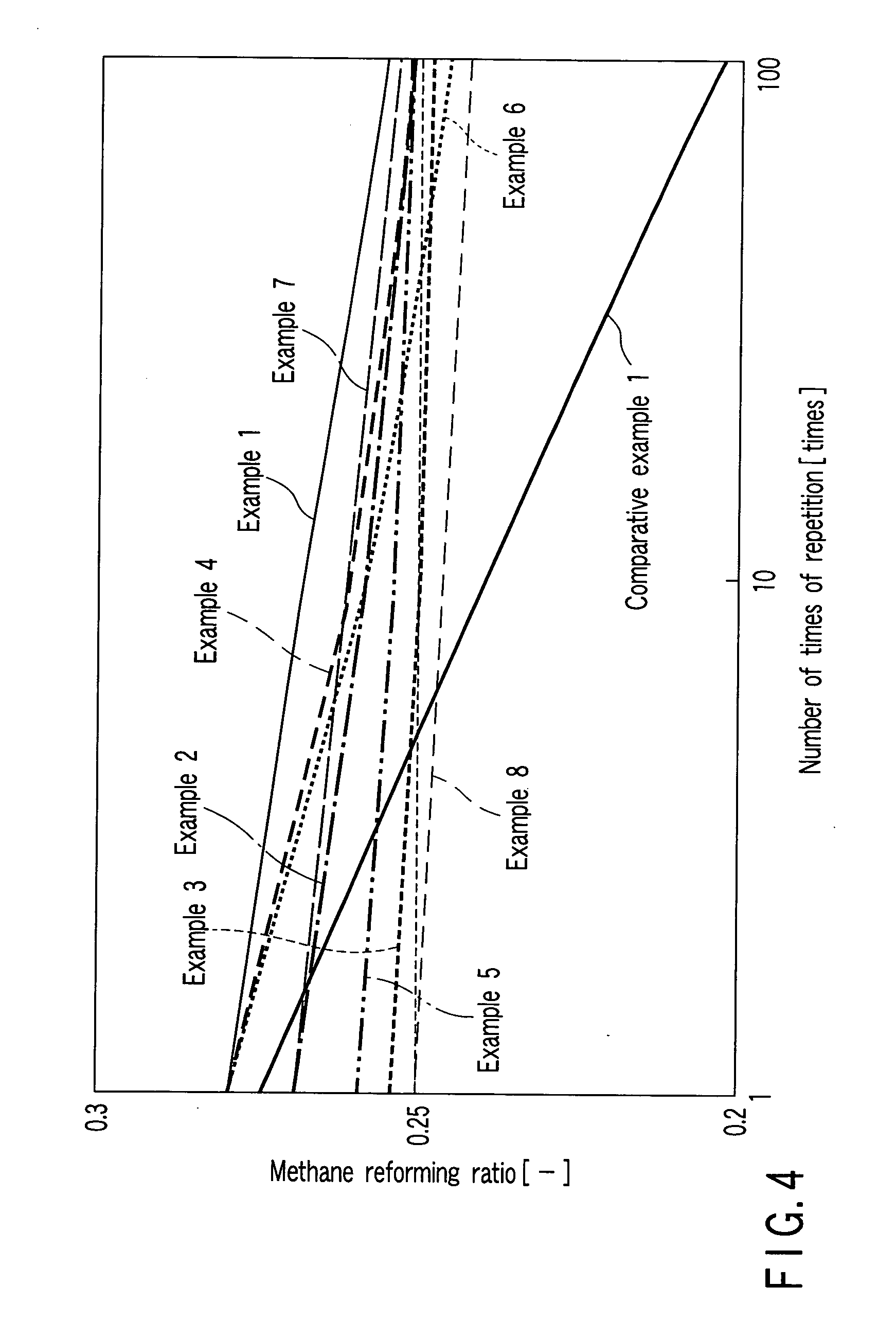Catalyst-containing reaction accelerator and steam reforming method using hydrocarbon
a catalyst and reaction accelerator technology, applied in the direction of physical/chemical process catalysts, other chemical processes, separation processes, etc., can solve the problems of reducing the specific surface area, deteriorating the catalytic action, and reducing the performance of solid catalysts after long-term us
- Summary
- Abstract
- Description
- Claims
- Application Information
AI Technical Summary
Problems solved by technology
Method used
Image
Examples
example 1
[0065] A silicon dioxide powder having an average particle diameter of 10 μm, a lithium carbonate powder having an average particle diameter of 1 μm, and a potassium carbonate powder having an average particle diameter of 1 μm were so weighed that the molar ratio of silicon dioxide:lithium carbonate:potassium carbonate was 1:2:0.1, thereby obtaining a material powder. Subsequently, 10 wt % of a fibrous lithium titanate powder having an average diameter of 0.5 μm and an average length of 15 μm were added to the material powder. The mixture was milled and mixed by a ball mill. The resultant material powder mixture was heated in a boxy electric oven in the atmosphere at 900° C. for 8 hrs, thereby synthesizing lithium silicate (a composite absorbent material) containing the fibrous lithium titanate. The obtained composite absorbent material was milled by the ball mill such that the lithium silicate had an average particle diameter of 5 μm, and the fibrous lithium titanate had an average...
example 2
[0067] 20 wt % of a fibrous lithium titanate powder having an average diameter of 0.5 μm and an average length of 15 μm were added to a material powder containing a silicon dioxide powder, lithium carbonate powder, and potassium carbonate powder similar to those of Example 1. The mixture was milled and mixed by a ball mill. The resultant material powder mixture was heated in a boxy electric oven at 900° C. for 8 hrs, thereby synthesizing lithium silicate (a composite absorbent material) containing the fibrous lithium titanate. The obtained composite absorbent material was milled by the ball mill such that the lithium silicate had an average particle diameter of 5 μm, and the fibrous lithium titanate had an average length of 10 μn. This composite absorbent material powder was filled in a metal mold having an inner diameter of 5 mm, and molded under pressure to form a columnar composite absorbent. This composite absorbent had a diameter of 5 mm and a length of 8 mm. In addition, the c...
example 3
[0069] 30 wt % of a fibrous lithium titanate powder having an average diameter of 0.5 μm and an average length of 15 μm were added to a material powder containing a silicon dioxide powder, lithium carbonate powder, potassium carbonate powder similar to those of Example 1. The mixture was milled and mixed by a ball mill. The resultant material powder mixture was heated in a boxy electric oven at 900° C. for 8 hrs, thereby synthesizing lithium silicate (a composite absorbent material) containing the fibrous lithium titanate. The obtained composite absorbent material was milled by the ball mill such that the lithium silicate had an average particle diameter of 5 μm, and the fibrous lithium titanate had an average length of 10 μm. This composite absorbent material powder was filled in a metal mold having an inner diameter of 5 mm, and molded under pressure to form a columnar composite absorbent. This composite absorbent had a diameter of 5 mm and a length of 8 mm. In addition, the compo...
PUM
| Property | Measurement | Unit |
|---|---|---|
| Temperature | aaaaa | aaaaa |
| Temperature | aaaaa | aaaaa |
| Diameter | aaaaa | aaaaa |
Abstract
Description
Claims
Application Information
 Login to View More
Login to View More - R&D
- Intellectual Property
- Life Sciences
- Materials
- Tech Scout
- Unparalleled Data Quality
- Higher Quality Content
- 60% Fewer Hallucinations
Browse by: Latest US Patents, China's latest patents, Technical Efficacy Thesaurus, Application Domain, Technology Topic, Popular Technical Reports.
© 2025 PatSnap. All rights reserved.Legal|Privacy policy|Modern Slavery Act Transparency Statement|Sitemap|About US| Contact US: help@patsnap.com



